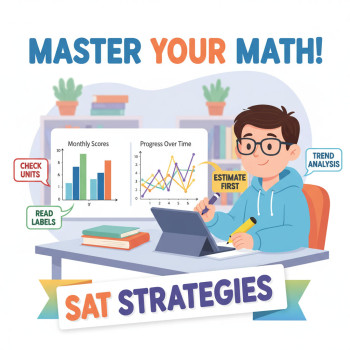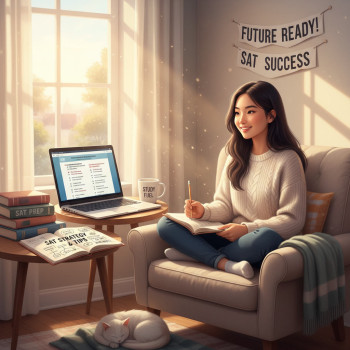Why the Digital SAT Demands a Smarter Reading Strategy
Let’s begin with something obvious but often overlooked: the Digital SAT isn’t just a paper test zoomed onto a screen. The digital format changes how passages feel, how your eyes move, and how time pressures compound. Whether you’re doing practice tests in Bluebook or working through question banks, the keys to higher reading scores are strategy, rhythm, and a few practical habits you can drill until they become second nature.
If you’ve already mastered the basics—vocabulary-in-context, main idea questions, and evidence pairing—this post will take you further. Below are advanced, tactical approaches that top scorers use: ways to read less while comprehending more and to answer more accurately under timed conditions. I’ll also include concrete examples, a compact study plan, and suggestions for when personalized help (like Sparkl’s 1-on-1 tutoring and tailored study plans) can give you an edge.
Before You Read: Set Up to Win
1. Configure your testing environment in practice
On test day your digital environment will be preset, but in practice you can control a lot. Make sure you practice on the same device type if possible, learn the Bluebook tool bar, and get comfortable with features like highlighting, strikethrough, and passage zoom. Repetition removes friction; friction kills speed and confidence.
2. Skim with a purpose
Skimming isn’t sloppy reading. It’s strategic triage: find the heart of the passage in 20–30 seconds so your eyes know where to land when questions ask for specifics. Try this simple frame:
- Read the first paragraph closely—authors often state the thesis or context there.
- Read the first sentence of each subsequent paragraph. These topic sentences give you the passage skeleton.
- Glance at the last paragraph for the conclusion or author stance.
This skimming should take 25–40 seconds for a 500–700 word passage. It gives you a mental map of flow and argument without drowning in details you can recover later.
During Reading: Active Techniques That Save Time
3. Passage mapping: your mental GPS
Passage mapping means building a short internal outline as you skim. Think of it as annotation in your head (or short notes if you prefer). A simple map includes:
- Author’s main claim or subject (1–2 words).
- Purpose (to argue, to explain, to narrate, to compare).
- Paragraph roles (background, contrast, evidence, counterargument, conclusion).
Example: For a science-history passage, your mental map might read: “Claim: fossil evidence revises timeline. Purpose: argue. P1 background; P2 new data; P3 method; P4 implications; P5 rebuttal & conclusion.” That map anchors your search when questions ask “where is the author discussing method?”
4. Highlight selectively—two lanes only
In digital testing, highlighting is powerful but often overused. Use exactly two highlight types in practice: (A) thesis/main claim and (B) evidence or result sentences. Train yourself to stop after highlighting these; anything else is noise you’ll skim back to if necessary.
5. The question-first trick for targeted reading
Not every question requires a full reread of the passage. For detailed “line reference” or “detail” questions, immediately jump to the question and then locate the referenced lines in the passage. For main-idea or function questions, refer back to your mental map. The test gives you a limited number of questions per passage—use that to prioritize which paragraphs you’ll read carefully.
Answering Strategies: How to Choose Correctly and Quickly
6. Evidence-based elimination
Many wrong answers on the Digital SAT are attractive because they sound plausible. Your first defense is evidence-based elimination: for every answer choice ask, “Which sentence in the passage supports this?” If you can’t point to explicit textual support—or if support depends on an additional assumption—drop it.
7. Distinguish inference from assumption
The SAT loves inference. The difference is subtle: an inference follows logically from what the author actually says; an assumption requires adding something not stated. Always ask: “Does the author say this, or am I adding context?” If the choice needs extra information, cross it out.
8. Watch out for extreme language
Choices using absolutes—always, never, all—are often incorrect unless the passage explicitly supports an extreme. The author’s stance on the SAT tends to be measured; answer choices that mirror that tone are safer.
Time Management: Keep the Clock in Your Favor
9. Section pacing breakdown
Because the digital SAT adapts differently across sections, your pacing model should be flexible. Here’s a compact approach you can practice and tweak to your speed:
| Task | Target Time | Notes |
|---|---|---|
| Skim and map passage | 25–40 sec | Shorter for narrative passages, longer for dense science/philosophy |
| Answer detail questions | 45–75 sec per question | Jump-to-line for efficiency |
| Main-idea/Author tone questions | 20–40 sec | Use your mental map |
| Remaining review & educated guesses | Last 3–5 minutes per passage block | Always guess—no penalty for wrong answers |
Practice with a stopwatch. Your first aim is consistent pacing; speed comes from repeated exposure.
Advanced Reading Tactics: Small Moves, Big Gains
10. Use the question’s wording to pinpoint answers
Look for signal words in questions—function, tone, imply, according to the author—that change how you search. “Function” asks why a phrase is there; “tone” wants the author’s attitude. Adjust your search target accordingly: sentences about attitude vs. sentences that explain or exemplify.
11. Chunk long comparative/multi-author passages
When a passage compares two perspectives, mentally label them A and B and note each author’s claim in one short line. Then address comparative questions by contrasting those two lines. The complexity collapses into a tidy table in your head.
12. Mini pagination: track where answers live
In digital tests you don’t physically flip pages, but you can still assign paragraph numbers in your mind or short on-screen notes: P1, P2, P3. When a question references a certain theme, quickly jump to that paragraph number—your brain will already know what role the paragraph played from your initial map.
Practice That Makes Strategy Automatic
13. Deliberate practice checklist
Every practice session should target specific skills—don’t just grind random passages. Use this checklist:
- 10 timed passages: track pacing and error patterns.
- 5 untimed passages: focus on mapping and highlighting discipline.
- Review logs: note recurring wrong-answer types (misread lines, inference mistakes, vocabulary traps).
- One focused drill: e.g., only evidence-based questions for a week.
14. Use Bluebook and the Student Question Bank (SQB)
The College Board’s digital practice tools let you simulate test conditions and identify skill-based gaps. After practice tests, use the SQB to target weak areas—ask for sets that focus only on evidence questions or comparative passages.
Real-World Example: Putting It All Together
Imagine a 600-word passage about urban green spaces that argues parks improve mental health but notes socioeconomic access issues. Here’s a compact play-by-play:
- Skim: identify thesis in paragraph 1, note a paragraph that provides scientific data, one that tells a personal anecdote, and a paragraph with counterarguments.
- Map: “Claim = parks help mental health; evidence = two studies; counter = access disparity.”
- Question: “What does the author mean by ‘equity gap’?” Jump to the counterargument paragraph, read two sentences, and answer.
- Question: “Which choice best describes tone?” Use thesis and concluding paragraph to judge measured optimism vs. alarm—choose measured optimism if the conclusion calls for policy adjustments rather than catastrophe.
That approach keeps you from rereading everything and aligns answer choices to actual text snippets.
Common Pitfalls and How to Avoid Them
15. Pitfall: Over-highlighting
Fix: Commit to two highlight types (thesis & evidence). If you highlight more, you’ll waste time deciding which highlight mattered.
16. Pitfall: Reading every sentence thoroughly
Fix: Train for triage. Not every sentence is equally valuable for every question. Trust your mapping to tell you where to dive deep.
17. Pitfall: Letting a hard question derail the passage
Fix: Flag it, move on, and return later with fresh perspective during the review window. The SAT rewards steady progress.
Sample Two-Week Advanced Reading Study Plan
Here’s a compact plan you can adapt. It assumes you already have basic SAT skills and want to sharpen advanced reading technique.
| Day | Focus | Time |
|---|---|---|
| 1–3 | Skimming + passage mapping drills (short passages) | 45–60 min/day |
| 4–6 | Evidence-based question practice + highlight discipline | 60 min/day |
| 7 | Half timed section in Bluebook; review errors | 90–120 min |
| 8–10 | Comparative/multi-author passages + inference drills | 60–75 min/day |
| 11–13 | Full timed Reading section; practice pacing & review | 90–120 min/day |
| 14 | Simulated test block and reflection; update study logs | 2–3 hours |
Repeat and adapt based on your performance. Focused, short bursts beat marathon sessions that dilute attention.
When Personalized Tutoring Helps—And How to Use It Well
Self-study is powerful, but targeted coaching accelerates results. If you’re stuck on a pattern like misreading inference questions or losing time on dense science passages, 1-on-1 guidance can break that loop faster than solo practice. Sparkl’s personalized tutoring offers tailored study plans, expert tutors, and even AI-driven insights to zero in on those patterns. Use tutoring to:
- Diagnose persistent error types with a tutor’s fresh perspective.
- Practice verbal protocols (thinking aloud) so a tutor can correct process-level mistakes.
- Build a customized schedule that fits your school workload and test date.
Good tutors won’t just give answers—they’ll teach decision rules that transfer to every passage you’ll see.
Cheat-Sheet: 12 Rapid Reminders for Test Day
- Skim for a map, not micro-detail.
- Highlight only thesis and evidence.
- Answer by evidence—always point back to the passage.
- Use the question-first approach for line-reference items.
- Label comparative authors A & B to avoid mixing claims.
- Flag and move on; don’t let one question derail you.
- Watch for extreme language in answer choices.
- When in doubt, prefer choices that reflect the author’s tone.
- Practice on the same device type when possible.
- Time-box your passage mapping to ~30 seconds.
- Always guess—no penalty for wrong answers.
- Review logs weekly and adjust practice focuses.

Final Thoughts: Make Strategy Your Default
Advanced reading on the Digital SAT is less about reading faster and more about reading smarter. When you move from passive reading to strategic mapping, selective highlighting, and evidence-first answering, you stop being surprised by questions and start anticipating them. That shift—from reactive to proactive—is what separates good practice from great practice.
If you want to accelerate that shift, consider a short run of focused sessions with an expert who can diagnose your patterns and give you a tailored plan. Sparkl’s personalized tutoring can be especially helpful here: one-on-one guidance, targeted drills, and AI-informed insights make practice more efficient and less guesswork.
Above all, be patient with yourself. The Digital SAT rewards calm, consistent strategy. Train the approach described here with honest timed practice, learn from each review, and your comprehension, accuracy, and confidence will climb together.
Quick Resources to Keep You Practicing
Keep rotating practice types—timed sections, untimed deep reads, and targeted question drills. Use the digital practice app regularly to stay comfortable with the testing interface, and track patterns in a simple error log. With focused work and the right habits, the Reading section will stop feeling like a hurdle and start feeling like the place you consistently pick up points.
Ready to start?
Set one micro-goal for today: do two timed passages and log every incorrect answer with a 2-line note about why it was wrong. That tiny habit compounds quickly. Good luck—and remember: with the right strategy, the Digital SAT’s Reading section is a place to gain reliable, test-day points.














No Comments
Leave a comment Cancel